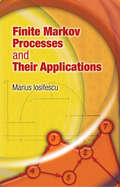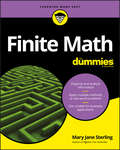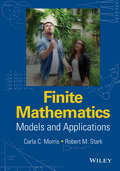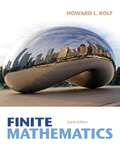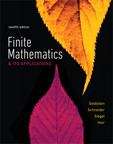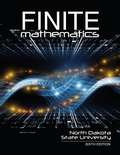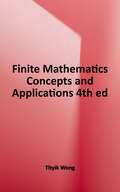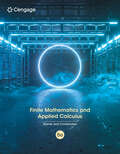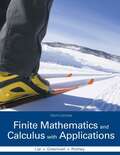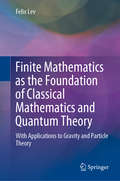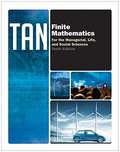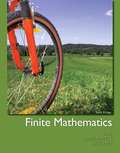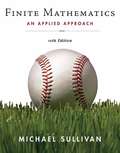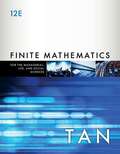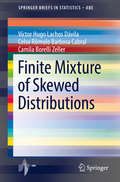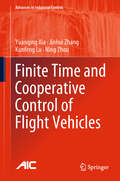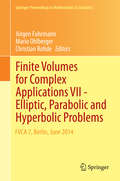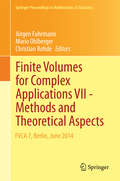- Table View
- List View
Finite Geometry and Combinatorial Applications
by Simeon BallThe projective and polar geometries that arise from a vector space over a finite field are particularly useful in the construction of combinatorial objects, such as latin squares, designs, codes and graphs. This book provides an introduction to these geometries and their many applications to other areas of combinatorics. Coverage includes a detailed treatment of the forbidden subgraph problem from a geometrical point of view, and a chapter on maximum distance separable codes, which includes a proof that such codes over prime fields are short. The author also provides more than 100 exercises (complete with detailed solutions), which show the diversity of applications of finite fields and their geometries. Finite Geometry and Combinatorial Applications is ideal for anyone, from a third-year undergraduate to a researcher, who wishes to familiarise themselves with and gain an appreciation of finite geometry.
Finite Markov Processes and Their Applications
by Marius IosifescuA self-contained treatment of finite Markov chains and processes, this text covers both theory and applications. Author Marius Iosifescu, vice president of the Romanian Academy and director of its Center for Mathematical Statistics, begins with a review of relevant aspects of probability theory and linear algebra. Experienced readers may start with the second chapter, a treatment of fundamental concepts of homogeneous finite Markov chain theory that offers examples of applicable models.The text advances to studies of two basic types of homogeneous finite Markov chains: absorbing and ergodic chains. A complete study of the general properties of homogeneous chains follows. Succeeding chapters examine the fundamental role of homogeneous infinite Markov chains in mathematical modeling employed in the fields of psychology and genetics; the basics of nonhomogeneous finite Markov chain theory; and a study of Markovian dependence in continuous time, which constitutes an elementary introduction to the study of continuous parameter stochastic processes.
Finite Math For Dummies
by Mary Jane SterlingUse mathematical analysis in the real world Finite math takes everything you've learned in your previous math courses and brings them together into one course with a focus on organizing and analyzing information, creating mathematical models for approaching business decisions, using statistics principles to understand future states, and applying logic to data organization. Finite Math For Dummies tracks to a typical college-level course designed for business, computer science, accounting, and other non-math majors, and is the perfect supplement to help you score high! Organize and analyze information Apply calculation principles to real-world problems Use models for business calculations Supplement your coursework with step-by-step example problems If you’re not a math person or just want to brush up on your skills to get a better grade, Finite Math For Dummies is your ticket to scoring higher!
Finite Mathematics
by Robert M. Stark Carla C. MorrisFeatures step-by-step examples based on actual data and connects fundamental mathematical modeling skills and decision making concepts to everyday applicability Featuring key linear programming, matrix, and probability concepts, Finite Mathematics: Models and Applications emphasizes cross-disciplinary applications that relate mathematics to everyday life. The book provides a unique combination of practical mathematical applications to illustrate the wide use of mathematics in fields ranging from business, economics, finance, management, operations research, and the life and social sciences. In order to emphasize the main concepts of each chapter, Finite Mathematics: Models and Applications features plentiful pedagogical elements throughout such as special exercises, end notes, hints, select solutions, biographies of key mathematicians, boxed key principles, a glossary of important terms and topics, and an overview of use of technology. The book encourages the modeling of linear programs and their solutions and uses common computer software programs such as LINDO. In addition to extensive chapters on probability and statistics, principles and applications of matrices are included as well as topics for enrichment such as the Monte Carlo method, game theory, kinship matrices, and dynamic programming. Supplemented with online instructional support materials, the book features coverage including: Algebra Skills Mathematics of Finance Matrix Algebra Geometric Solutions Simplex Methods Application Models Set and Probability Relationships Random Variables and Probability Distributions Markov Chains Mathematical Statistics Enrichment in Finite Mathematics An ideal textbook, Finite Mathematics: Models and Applications is intended for students in fields from entrepreneurial and economic to environmental and social science, including many in the arts and humanities.
Finite Mathematics
by Howard L. RolfGet the background you need and discover the usefulness of mathematics in analyzing and solving problems with FINITE MATHEMATICS, Eighth Edition. The author clearly explains concepts, and the computations demonstrate enough detail to allow you to follow and learn steps in the problem-solving process. Hundreds of examples and exercises, many based on real-world data, illustrate the practical applications of mathematical concepts. <p><p>The book also includes technology guidelines to help you successfully use graphing calculators and Microsoft Excel to solve selected exercises. Available with InfoTrac Student Collections http://gocengage.com/infotrac.
Finite Mathematics & Its Applications (12th Edition)
by David I. Schneider Larry J. Goldstein Martha J. Siegel Steven M. HairFor Finite Math courses for students majoring in business, economics, life science, or social sciences <p><p> The most relevant choice<p> Finite Mathematics is a comprehensive yet flexible text for students majoring in business, economics, life science, or social sciences. Its varied and relevant applications are designed to pique and hold student interest, and the depth of coverage provides a solid foundation for students’ future coursework and careers. Built-in, optional instruction for the latest technology—graphing calculators, spreadsheets, and WolframAlpha—gives instructors flexibility in deciding how to integrate these tools into their course. Thousands of well-crafted exercises–a hallmark of this text–are available in print and online in MyLab™ Math to enable a wide range of practice in skills, applications, concepts, and technology.<p> In the 12th Edition, new co-author Steve Hair (Pennsylvania State University) brings a fresh eye to the content and MyLab™ Math course based on his experience in the classroom. In addition to its updated applications, exercises, and technology coverage, the revision infuses modern topics such as health statistics and content revisions based on user feedback. The authors relied on aggregated student usage and performance data from MyLab™ Math to improve the quality and quantity of exercises.
Finite Mathematics (Sixth Edition)
by Department of Mathematics NdsuA mathematics textbook for undergraduates.
Finite Mathematics Concepts and Applications
by Tityik WongThis book has been used by the author at the College of Southern Nevada since 2018. It serves as a college freshman level finite mathematics textbook. The major topics in a typical finite mathematics course (mathematics of finance, set theory, linear algebra, counting techniques, probability and statistics) are covered. The book emphasizes the thinking and reasoning aspects of mathematics. The goal is to help students acquire certain amount of useful knowledge, and at the same time become better critical thinkers. Some new approaches to old topics and some new topics are included in the book.
Finite Mathematics and Applied Calculus
by Steven R. Costenoble Stefan WanerShow students the relevance of mathematics in their own lives as they master important concepts and skills in Waner/Costenoble’s FINITE MATHEMATICS AND APPLIED CALCULUS, 8th Edition. Updated, numerous examples and applications engage students with real data from well-known businesses, economic, social and current life events -- from cryptocurrency to COVID. Streamlined content assists in comprehension while valuable print and digital resources work seamlessly for your in-person, online or hybrid course format. Spreadsheet and TI graphing calculator instruction appears where needed throughout the text. Optional end-of-chapter Technology Notes and Technology Guides are available to include the precise amount of technology instruction you prefer. WebAssign course management resources and an acclaimed author website further engage students in interactive learning. Noted for both readability and accuracy, this edition is ideal for all types of teaching and learning styles and support.
Finite Mathematics and Calculus with Applications
by Margaret Lial Raymond Greenwell Nathan RitcheyFinite Mathematics and Calculus with Applications, Tenth Edition by Lial, Greenwell, and Ritchey, is our most applied text to date, making the math relevant and accessible for students of business, life science, and social sciences. Current applications, many using real data, are incorporated in numerous forms throughout the book, preparing students for success in their professional careers. With this edition, students will find new ways to help them learn the material, such as Warm-Up Exercises and added “help text” within examples.
Finite Mathematics as the Foundation of Classical Mathematics and Quantum Theory: With Applications to Gravity and Particle Theory
by Felix LevThis book delves into finite mathematics and its application in physics, particularly quantum theory. It is shown that quantum theory based on finite mathematics is more general than standard quantum theory, whilst finite mathematics is itself more general than standard mathematics.As a consequence, the mathematics describing nature at the most fundamental level involves only a finite number of numbers while the notions of limit, infinite/infinitesimal and continuity are needed only in calculations that describe nature approximately. It is also shown that the concepts of particle and antiparticle are likewise approximate notions, valid only in special situations, and that the electric charge and baryon- and lepton quantum numbers can be only approximately conserved.
Finite Mathematics for Business, Economics, Life Sciences, and Social Sciences (Thirteenth Edition)
by Raymond A. Barnett Michael R. Ziegler Karl E. ByleenLearn about the math that will help you in many careers and academic disciplines.
Finite Mathematics for the Managerial, Life, and Social Sciences (Tenth Edition)
by Soo T. TanThe text pairs pioneering technology with rock-solid theory, delivering matchless flexibility to both traditional and modern practitioners. The text abounds with helpful examples, exercises, applications, and features to motivate further exploration.
Finite Mathematics, 10th Edition
by Margaret L. Lial Raymond N. Greenwell Nathan P. RitcheyFinite Mathematics is a thorough, application-oriented text for students majoring in business, management, economics, or the life or social sciences.
Finite Mathematics: An Applied Approach (Tenth edition)
by Michael SullivanThis comprehensive book on finite mathematics covers wide range of topics like linear equations, linear systems, linear programming,basic mathematics of finance, set theory and basic combinatorics, probability and statistics, etc.
Finite Mathematics: For The Managerial, Life, And Social Sciences
by Soo T. TanFINITE MATHEMATICS FOR THE MANAGERIAL, LIFE, AND SOCIAL SCIENCES, Twelfth Edition, is a clear, easy-to-follow text that balances contemporary mathematics applications and the latest technology to help give you the key problem-solving skills you need for your life and career in the 21st century. Real-world applications put math concepts in context and cover topics including social media accounts, corporate fraud, criminal justice, cyber privacy, starting a new job, gas prices, smartphone ownership, mobile ad revenues, and more.
Finite Mixture of Skewed Distributions (SpringerBriefs in Statistics)
by Víctor Hugo Lachos Dávila Celso Rômulo Cabral Camila Borelli ZellerThis book presents recent results in finite mixtures of skewed distributions to prepare readers to undertake mixture models using scale mixtures of skew normal distributions (SMSN). For this purpose, the authors consider maximum likelihood estimation for univariate and multivariate finite mixtures where components are members of the flexible class of SMSN distributions. This subclass includes the entire family of normal independent distributions, also known as scale mixtures of normal distributions (SMN), as well as the skew-normal and skewed versions of some other classical symmetric distributions: the skew-t (ST), the skew-slash (SSL) and the skew-contaminated normal (SCN), for example. These distributions have heavier tails than the typical normal one, and thus they seem to be a reasonable choice for robust inference. The proposed EM-type algorithm and methods are implemented in the R package mixsmsn, highlighting the applicability of the techniques presented in the book.This work is a useful reference guide for researchers analyzing heterogeneous data, as well as a textbook for a graduate-level course in mixture models. The tools presented in the book make complex techniques accessible to applied researchers without the advanced mathematical background and will have broad applications in fields like medicine, biology, engineering, economic, geology and chemistry.
Finite Ordered Sets: Concepts, Results and Uses
by Nathalie Caspard Bruno Leclerc Bernard MonjardetOrdered sets are ubiquitous in mathematics and have significant applications in computer science, statistics, biology and the social sciences. As the first book to deal exclusively with finite ordered sets, this book will be welcomed by graduate students and researchers in all of these areas. Beginning with definitions of key concepts and fundamental results (Dilworth's and Sperner's theorem, interval and semiorders, Galois connection, duality with distributive lattices, coding and dimension theory), the authors then present applications of these structures in fields such as preference modelling and aggregation, operational research and management, cluster and concept analysis, and data mining. Exercises are included at the end of each chapter with helpful hints provided for some of the most difficult examples. The authors also point to further topics of ongoing research.
Finite Precision Number Systems and Arithmetic
by Peter Kornerup David W. MatulaFundamental arithmetic operations support virtually all of the engineering, scientific, and financial computations required for practical applications, from cryptography, to financial planning, to rocket science. This comprehensive reference provides researchers with the thorough understanding of number representations that is a necessary foundation for designing efficient arithmetic algorithms. Using the elementary foundations of radix number systems as a basis for arithmetic, the authors develop and compare alternative algorithms for the fundamental operations of addition, multiplication, division, and square root with precisely defined roundings. Various finite precision number systems are investigated, with the focus on comparative analysis of practically efficient algorithms for closed arithmetic operations over these systems. Each chapter begins with an introduction to its contents and ends with bibliographic notes and an extensive bibliography. The book may also be used for graduate teaching: problems and exercises are scattered throughout the text and a solutions manual is available for instructors.
Finite Time and Cooperative Control of Flight Vehicles (Advances in Industrial Control)
by Yuanqing Xia Jinhui Zhang Kunfeng Lu Ning ZhouThis book focuses on the finite-time control of attitude stabilization, attitude tracking for individual spacecraft, and finite-time control of attitude synchronization. It discusses formation reconfiguration for multiple spacecraft in complex networks, and provides a new fast nonsingular terminal sliding mode surface (FNTSMS). Further, it presents newly designed controllers and several control laws to enhance the performance of spacecraft systems and meet related demands, such as strong disturbance rejection and high-precision control. As such, the book establishes a fundamental framework for these topics, while also highlighting the importance of integrated analysis. It is a useful resource for all researchers and students who are interested in this field, as well as engineers whose work involves designing flight vehicles.
Finite Volume Methods for Hyperbolic Problems
by Randall J. LevequeThis book contains an introduction to hyperbolic partial differential equations and a powerful class of numerical methods for approximating their solution, (including both linear problems and nonlinear conservation laws). These equations describe a wide range of wave propagation and transport phenomena arising in nearly every scientific and engineering discipline. Several applications are described in a self-contained manner, along with much of the mathematical theory of hyperbolic problems. High-resolution versions of Godunov's method are developed, in which Riemann problems are solved to determine the local wave structure and limiters are applied to eliminate numerical oscillations. The methods were orginally designed to capture shock waves accurately, but are also useful tools for studying linear wave-progagation problems, particulary in heterogenous material. The methods studied are in the CLAWPACK software package. Source code for all the examples presented can be found on the web, along with animations of many of the simulations. This provides an excellent learning environment for understanding wave propagation phenomena and finite volume methods.
Finite Volume Methods for the Incompressible Navier–Stokes Equations (SpringerBriefs in Applied Sciences and Technology)
by Jian Li Zhangxing Chen Xiaolin LinThe book aims to provide a comprehensive understanding of the most recent developments in finite volume methods. Its focus is on the development and analysis of these methods for the two- and three-dimensional Navier-Stokes equations, supported by extensive numerical results. It covers the most used lower-order finite element pairs, with well-posedness and optimal analysis for these finite volume methods.The authors have attempted to make this book self-contained by offering complete proofs and theoretical results. While most of the material presented has been taught by the authors in a number of institutions over the past several years, they also include several updated theoretical results for the finite volume methods for the incompressible Navier-Stokes equations. This book is primarily developed to address research needs for students and academic and industrial researchers. It is particularly valuable as a research reference in the fields of engineering, mathematics, physics, and computer sciences.
Finite Volumes for Complex Applications IX - Methods, Theoretical Aspects, Examples: FVCA 9, Bergen, Norway, June 2020 (Springer Proceedings in Mathematics & Statistics #323)
by Jürgen Fuhrmann Robert Klöfkorn Eirik Keilegavlen Florin A. RaduThe proceedings of the 9th conference on "Finite Volumes for Complex Applications" (Bergen, June 2020) are structured in two volumes. The first volume collects the focused invited papers, as well as the reviewed contributions from internationally leading researchers in the field of analysis of finite volume and related methods. Topics covered include convergence and stability analysis, as well as investigations of these methods from the point of view of compatibility with physical principles. Altogether, a rather comprehensive overview is given on the state of the art in the field. The properties of the methods considered in the conference give them distinguished advantages for a number of applications. These include fluid dynamics, magnetohydrodynamics, structural analysis, nuclear physics, semiconductor theory, carbon capture utilization and storage, geothermal energy and further topics. The second volume covers reviewed contributions reporting successful applications of finite volume and related methods in these fields. The finite volume method in its various forms is a space discretization technique for partial differential equations based on the fundamental physical principle of conservation. Many finite volume methods preserve further qualitative or asymptotic properties, including maximum principles, dissipativity, monotone decay of free energy, and asymptotic stability, making the finite volume methods compatible discretization methods, which preserve qualitative properties of continuous problems at the discrete level. This structural approach to the discretization of partial differential equations becomes particularly important for multiphysics and multiscale applications. The book is a valuable resource for researchers, PhD and master’s level students in numerical analysis, scientific computing and related fields such as partial differential equations, as well as engineers working in numerical modeling and simulations.
Finite Volumes for Complex Applications VII-Elliptic, Parabolic and Hyperbolic Problems
by Jürgen Fuhrmann Mario Ohlberger Christian RohdeThe methods considered in the 7th conference on "Finite Volumes for Complex Applications" (Berlin, June 2014) have properties which offer distinct advantages for a number of applications. The second volume of the proceedings covers reviewed contributions reporting successful applications in the fields of fluid dynamics, magnetohydrodynamics, structural analysis, nuclear physics, semiconductor theory and other topics. The finite volume method in its various forms is a space discretization technique for partial differential equations based on the fundamental physical principle of conservation. Recent decades have brought significant success in the theoretical understanding of the method. Many finite volume methods preserve further qualitative or asymptotic properties, including maximum principles, dissipativity, monotone decay of free energy, and asymptotic stability. Due to these properties, finite volume methods belong to the wider class of compatible discretization methods, which preserve qualitative properties of continuous problems at the discrete level. This structural approach to the discretization of partial differential equations becomes particularly important for multiphysics and multiscale applications. Researchers, PhD and masters level students in numerical analysis, scientific computing and related fields such as partial differential equations will find this volume useful, as will engineers working in numerical modeling and simulations.
Finite Volumes for Complex Applications VII-Methods and Theoretical Aspects
by Jürgen Fuhrmann Mario Ohlberger Christian RohdeThe first volume of the proceedings of the 7th conference on "Finite Volumes for Complex Applications" (Berlin, June 2014) covers topics that include convergence and stability analysis, as well as investigations of these methods from the point of view of compatibility with physical principles. It collects together the focused invited papers, as well as the reviewed contributions from internationally leading researchers in the field of analysis of finite volume and related methods. Altogether, a rather comprehensive overview is given of the state of the art in the field. The finite volume method in its various forms is a space discretization technique for partial differential equations based on the fundamental physical principle of conservation. Recent decades have brought significant success in the theoretical understanding of the method. Many finite volume methods preserve further qualitative or asymptotic properties, including maximum principles, dissipativity, monotone decay of free energy, and asymptotic stability. Due to these properties, finite volume methods belong to the wider class of compatible discretization methods, which preserve qualitative properties of continuous problems at the discrete level. This structural approach to the discretization of partial differential equations becomes particularly important for multiphysics and multiscale applications. Researchers, PhD and masters level students in numerical analysis, scientific computing and related fields such as partial differential equations will find this volume useful, as will engineers working in numerical modeling and simulations.

